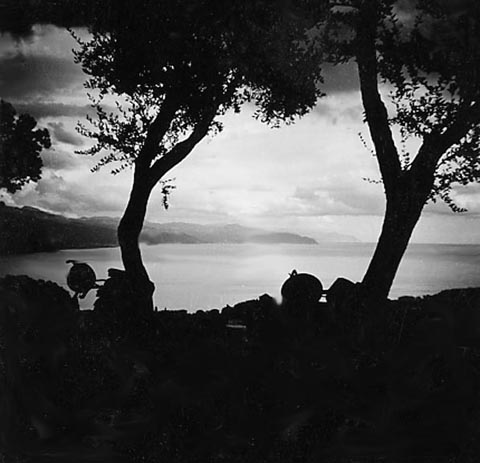
|
Italy Summer
1952 with Gerhard |

4 August to 12 October, 1952
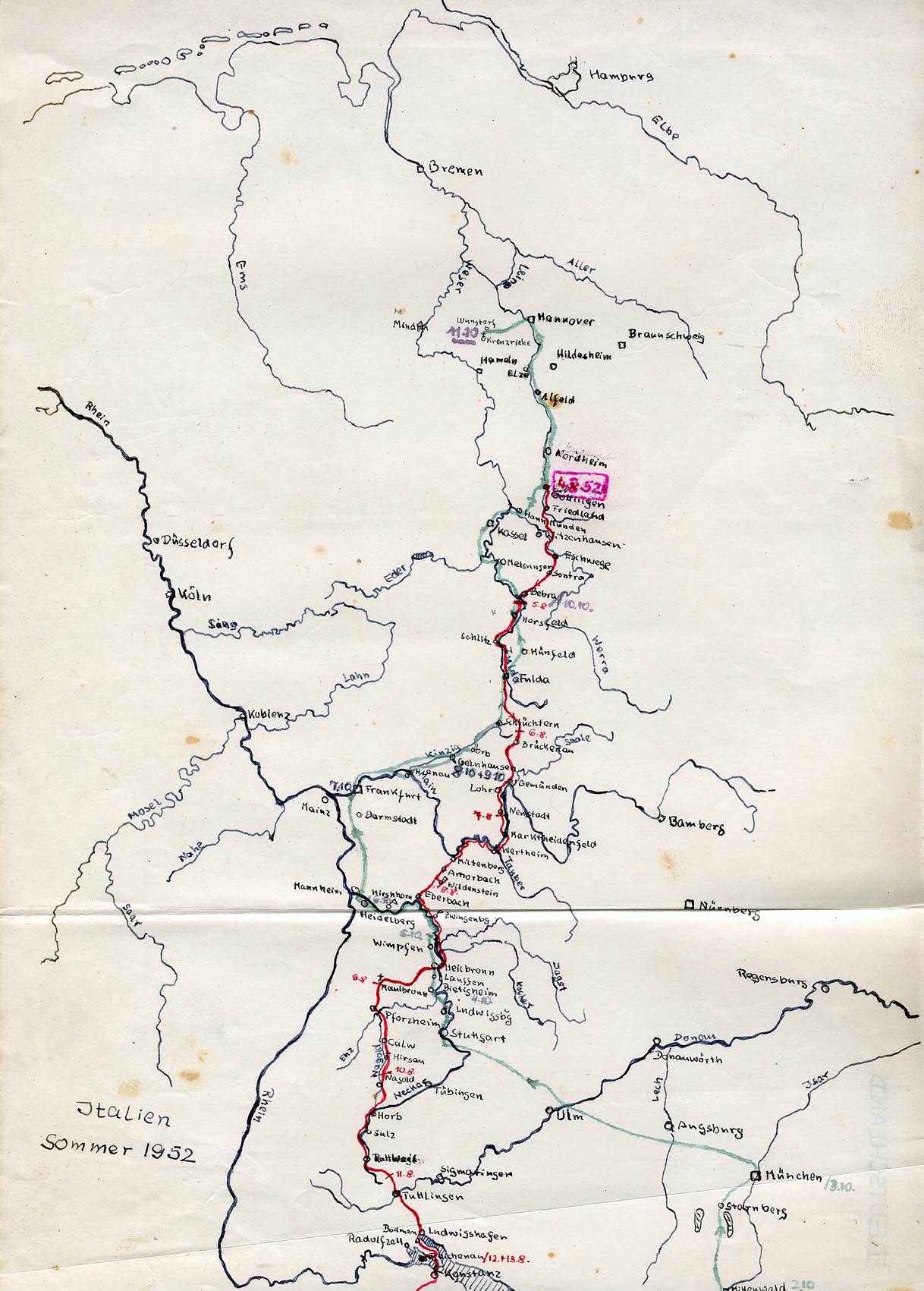
Route through Germany: in red with bicycles, return route in green (auto- and boat-stop)

In 1952 Gerhard and I rented a room in Göttingen with a roof balcony (the left two windows on the 3 floor) on Baurat Gerber Str. 19 in the apartment of Frau Phillips and her secretly homosexual, 35-year old son. Frau Phillips, a slender and dear 68-years old lady, was the nicest landlady we ever had during our years in Göttingen. After a last breakfast on our balcony, loaded with sleeping bags, a tent, and all the good wishes of Frau Phillips we started on our journey. We now had a camera! A steel box camera with a simple lens and a click-shutter which produced 2x2" square pictures on roll-film with which all the following pictures were taken. Restoring and enlarging them now revealed their unexpected sharpness for the first time - truly amazing.
The map below shows our route via Kassel and Fulda across the Rhön into the Main Valley. Near Neustadt (Gmünden) we set up the tent on a meadow below the cemetery where Brigitte and I had also camped in 1950.
|
Camp site above the Main near the cemetery of Neustadt |
Gerhard washing-up in the morning |
Next morning we washed in a nearby spring and pedaled on along the Tauber Valley to Heilbronn. Half a day we resting in the beloved Monastery at Maulbronn. Two slow days later - a strong wind was blowing at us from the southwest - we reached the Island of Reichenau in Lake Constance, where we put up our tent in the garden of Mrs. Mahler, a kind lady vaguely related to the composer, right next to the lake. It was sunny and we loafed there, paddled on the lake and dreamed of warm and sunny Italy.
|
Gerhard on a day of rest on the Island of Reichenau. The Swiss shore of the Untersee is seen in the background. |
From there it was only an hour to Constance and the border station to Switzerland.

Route through Switzerland
The good burghers of Switzerland, especially in the Canton of Zug, showed themselves from their most unfriendly side. We were cussed and chased out of one village near Zug because it was a hot Sunday and we had taken our shirts off. "You Germans will spoil our youth. Naked on Sunday....!" Germany in those days, seven years after the War, was a poor country, and the towns of Switzerland appeared licked clean and stogy. But in the French part of the Wallis this got better, with much laughter we used our few words of French to beg permission to camp on a meadow under fruit trees and were given a load of pears and apples.
|
Chateaux de Chillon on the Lake of Constance |
The Rhone Valley and Sion |
It was warm and sunny, the wind blew from the south, and for a day there were no mountain passes to climb - by pushing the bikes, we only had three gears and much luggage. We flew up the Rhone Valley. That was when we began to live of half-ripe fruit - "picked-up" along the road - and chocolate and an occasional cigarette to counteract the effects of the green fruit.... Other goodies except bread were too expensive for us to buy, not to mention eating in restaurants. We had budgeted about 5 DM ($1!) per day for the two of us.... Every few days I carefully jotted down our expenses in my diary.
|
View from Simplon Road across Rhone Valley into the Berner Oberland |
Rain and snow grounded us for a day on the way to the Simplon Pass |
Italy lay on the other side of the mountains! Patiently we began pushing our bikes up the road to the Simplon Pass, while the clouds thickened. Night came when we had covered only two-thirds of the mountain on the miserable road. We put up the tent in a place from where we would have had a fabulous view if the Aletsch Glacier in the Berner Oberland on the other side of the Rhone Valley - had the view not vanished in the clouds. During the night it began to rain which towards morning turned into snow. We were stuck in the tent until three in the afternoon, when the rain let up. We packed up in a hurry and reached the 2000-m pass at 5:30 PM. Down we went at breakneck speed in the waning light. The bikes were rattling like crazy, and I prayed all the way to Domodossola that neither of us would have a spill on the wet, still unpaved, dangerously winding road. - But it got warmer as we reached the valley leading to Lago Maggiore. We set up our wet tent in complete darkness hiding from sight in a small meadow behind a row of trees and bushes. Next morning the owner of the land woke us. How to offer an explanation for our presence in Italian? I searched frantically for my little Italian dictionary.... It had disappeared, a disastrous loss. I only found it at night in Milan at the foot end of my sleeping bag.....

Route through Italy: red on bicycle, green our return by autostop
For one day we explored Milan : da Vinci's Last Supper, the Duomo - a heavy down-pour drenched us on its roof , because of our short Lederhosen they would not let us into its interior - and had lunch in a restaurant - veal, bread, a glass of wine.... Inclusive "coperto" and tip it cost us 1500 Lire (10 DM or two days allowance).... We never ate in a restaurant again - except in the people's kitchens in Florence and Rome.
|
Our straw hats in the grape vines of Tuscany near Pistoia |
Gerhard overlooking the port of Genoa |
Bread, olive oil, noodles, farina and tomatoes and grapes stolen from the vines, became our main stay. We carried a tiny alcohol burner the like one uses to keep food dishes warm at table - and I cooked for us. The great invention was to simmer tomatoes in oil without adding water and then stir in some farina to thicken the "pasta asciuta" - later we learned to stir-in a couple of eggs to make this dish more nourishing.... In the cities we occasionally bought a liter of milk. How we survived as long as we did on this diet remains a mystery to me today - pedaling up and down the hills was hard labor.
We reached the Mediterranean Coast in Genoa, which looked unenticing. We pedaled on along the coast. One night we settled in the "Youth Hostel" at Cavi di Lavagna, a touchingly improvised shack (they did have one shower stall for boys and girls) at the edge of the sea, where we made the acquaintance of a ravishing, dark Italian "ragazza" who spoke with the help of hands and feet a smattering of English. Next day the pushing uphill began anew - and it was hot! On Passo di Bracco we decided that we had had enough and rattled down an unimproved road to Moneglia and the shimmering sea. The girl in Cavi di Lavagna had described the village of Corniglia in glowing terms, in the Cinque Terre - as yet undiscovered by tourists. "Oh," she said, "you reach it by boat. There is also a train along the coast." The only road we found was closed off with a barricade and a sign: "Dangerous Road!" We clambered around the barricade and soon found ourselves in a half-collapsed "galleria" a 3-km long pitch-dark tunnel full of puddles and ankle-deep mud.... Undeterred we pushed on - and finally reached the promised paradise of Corniglia : white-washed houses climbing in terraces up a steep mountain-side from the sea - and everywhere the biggest, sweetest grapes! That night we sneaked into one vineyard and lying on our backs stripped the grapes directly into our mouths.... On the third day in this Land of Cockaigne we put the bikes on the morning train to La Spezia.

Water color by Gerhard of the boats on the beach at Marina di Ronchi near Viareggio
|
Our bicycles above the Ligurian Coast, Cinque Terre in the background |
The Duomo and the leaning Campanile in Pisa |
For two days we pedaled from Pisa through the small Tuscan towns, Pistoia, Montecatini Terme, Prato along the foothills of the Appenin to long-dreamed of Florence.
Look what artistic pictures one can take with a box camera! A yellow filter, which I had to hold in front of the lens, produced dramatic clouds, but the viewer had no parallax allowance and all the heads later turned out to be chopped off....
Florence
|
Michelangelo's David in the clouds |
Brunelleschi's dome seen from the Campanile |
We settled in the Youth Hostel, real beds, a kitchen, and an excited crowd of people from all over the world. The Hostel occupied a floor in a building of Mussolini's time. Its large inner courtyard, into which opened the windows of the hostel, housed an open-air cinema. Every night ran two movie shows, Impossible to go to sleep before 1:00 in the morning because of the noise everybody hung in the windows and watched the show from an highly distorted angle. To this day the music of Carmen rings in my ears which accompanied a film about the mixed up lives of two identical twins one of which had been deposited in an asilio dei innocenti..... Here we met the highly agitated couple from New Zealand who convinced us that it was possible to go to Greece. They had just been there! We also met Herbert Press there an architecture student and metal sculptor from Berlin who remained a close friend for many years.... We roamed the city and its museums during the day: climbed the Campanile, fought our way through the crowds in the Uffizi, stood before the frescos of the Brancacci Chapel, didn't like the Giottos in Santa Croce, found the Palazzo Pitti a horribly over-stuffed place ... and got drunk on color, paintings, and architecture.
|
The Duomo and the Campanile |
Palazzo Vecchio seen from the Campanile |
The most memorable paintings at the Uffizi were the "primitivi," the pre-Renaissance gold-ground paintings closely followed by Piero della Francesco's Montefeltre of which we bought a large reproduction - this and a short coral necklace for our sister were the only souvenirs we purchased on this trip. The Montefeltre hung in our room for many years - later Gerhard took it with him to America.... I found numerous postcards of other paintings - all Madonnas! - in my box of memorabilia from this first visit to Florence.
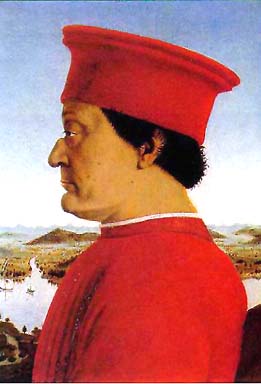
Piero della Francesco, Frederico della Montefeltre, Duke of Urbino, 1465
|
Simone Martini, Madonna of the Annunciation, 1333 |
Sandro Botticelli, Madonna of the Magnificat, 1485 |
I was more fascinated by the collection of Byzantine altar pieces and because of their expressionist quality by Michelangelo's powerful unfinished sculptures ("Prisoners") in the Accademia.
|
Michelangelo, Prisoner |
Michelangelo, Unfinished Pieta |
Through Tuscany to Rome
On October 4 we set out for Rome. A stiff head wind blew which would soon bring new clouds and rain. But it was still clear and sunny when we said good-bye to Florence from the Piazzale Michelangelo.
|
Florence seen from the Piazzale Michelangelo |
We had not expected to have to push our bikes over more hills and no idea of how bare the landscape between Florence and Siena was. Behind Radicofani the little chain on Gerhard's gear change broke for the third time, then his back-pedaling brake jammed, and finally on a steep down-hill I collided with his bike and broke all spokes of my front wheel..... The tensions between us became high - not to mention that the repair of the wheel cost as much as three days of food allowance. The poor nutrition and the hardships of the road began to take their toll.
|
Tuscan landscape near Radicofani |
Gerhard repairs his back-pedal-brake which had locked up |
|
Afraid of being flooded we put our tent on a Tuscan hill |
Siena the tower of the Palazzo Publico |
Too worn out we spent only an afternoon in Siena - which has since then become my favorite Tuscan city - that night it rained again. However, a clear morning a the black beaches of Lago di Bolsena gave us new courage. Rome was only 130 km further. We reached it in complete darkness that night.
|
An emaciated Gerhard watches the fishermen on Lago di Bolsena |
Gerhard picking figs for lunch in Umbria - we soon could not smell figs any longer not to mention eating them. |
Rome
The Youth Hostel in Rome was a dilapidated villa ready for demolition left over among ultra-modern apartment buildings on Monte Mario. Nobody ever cleaned the place, several million ants had taken over. They were tiny and not aggressive, but if one's bed happened to stand in their path they would creep right across one's nose. We put the feet of the beds into empty cans which had to be filled with water every night - but the food in our bags was not safe. On the other hand we found by word of mouth a cheap pasta kitchen - supported by the city - on Vico della Arco Ciambella (pretzel gate) where a large plate of pasta asciuta (with tomato sauce) cost only 40 Lit. Some days we ate each a plates at noon and one together at night.... At least the stomach was filled.
|
For two days we explored the Forum Romanum for free by jumping down two meters from its wall |
The Capitolinian Hill seen from the Forum |
Monte Mario is an outlying suburb and to get into town we had to ride the bikes or take the tram - which of course cost money. Going by bike had another problem: the legendary Bicycle Thieves! On the second day we met a young German whose bike had been stolen in the city. He later met an Italian bicycle capo who took him to the market where the dismantled bikes where sold, and there bought him a complete bike in parts. Very romantic - but prevention was better. One day we rode out along Via Antiqua and the catacombs - where the ubiquitous girls followed us through her ruins. Twice we explored the Forum for free by climbing across the wall in a remote corner. On the following day we explored the Roman churches by bike, and I got a hair cut - a daring undertaking with my poor Italian - he could have shaved it off completely - like the Duce....
Rome in 1952 struck me as a truly voluptuous city and not because of its prostitutes. It had a debauched atmosphere especially when viewed from Monte Mario at night. I don't mean it in a moral sense, it appeared old, abused, and crumbling like the villa we slept in. The discrepancy between the modern apartment buildings and its bourgeois inhabitants only added to this impression. Only Istanbul-Konstantinopolis later in 1954 struck me as more depraved than the "Holy City," but Istanbul is marked by the whoredom of the final Byzantine centuries and the rapes of uncounted conquerors - the puritan Moslems were culturally not strong enough to wipe the city's memory from its body.
Still the most beautiful object in Rome was not a painting but the dome of Michelangelo's as seen from the Vatican apartments.
|
Michelangelo's dome seen from the Vatican Museum |
We left Rome by way of Castel Gandolfo and the colorful Monte Albani from where we sailed down to the coast near Nettuno. A thunderstorm after sundown forced us onto the empty area of a "Zona Militare" for the night (the place where the Americans had landed in 1944). In the morning a gun stuck through the tent's entry woke us rather unceremoniously. We - dressed only in underpants - were detained by two soldiers and marched to headquarter - where a German-speaking colonel - memories of the good old days of German-Italian friendship - interrogated us for an hour. As time went on he became friendlier and friendlier and finally ordered coffee and a breakfast for us before he set us free. However, the real punishment for trespassing was four flat tires! No, the Spaghettis did not let the air out, a prickly desert plant - it also grows in California - had left uncounted punctures in out inner tubes. We spent 2 hours patching them.....
Once again it became cold and rained most of the day while we pedaling against a stiff wind around the Cape of Circe - and my intestines were livid....
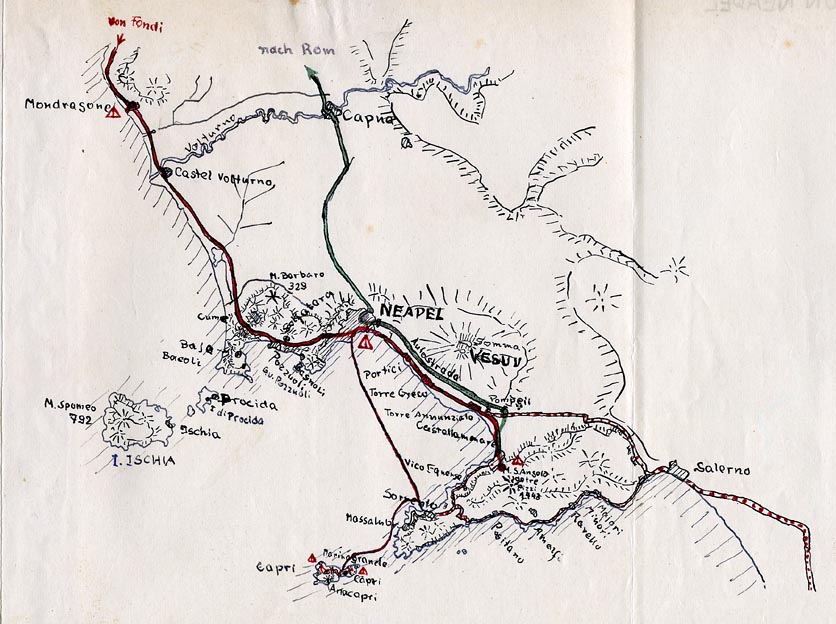
Route around Naples: from Naples by boat to Capri, on bicycles (red) to Castellamare di Stabia then by autostop (green) back to Rome and home. Sick and penniless we collapsed in the Youth Hostel in Castellamare and never made it to Pompeii and Paestum (by train) as we had planned .....
|
Beach near Cap di Circe |
Rained-out among epis near Fonai |
Drenched and miserable we collapsed in our tent in a cactus grove near Fonai. Too weak to get up we got stuck there for half a day before the rain let up. As we packed our bikes in the afternoon a man appeared with two young women, a blond and a dark one. He gave a long speech underlined by well-known international hand gestures advertising the two beauties. Wouldn't we like to try them, the blonde for me, the brunette for Gerhard? Gerhard was embarrassed, I finally shooed them away..... And then, in the local store we met a thirteen-year old girl as ravishingly beautiful as they only exist in southern countries. I was reminded of Goethe's Mignon. She pursued me in my dreams for days....
Naples, Capri, and Castellamare
We had 10'000 Lire left, how would we get home? Fate decided the matter. The dirt and poverty of Naples offered little attraction besides we were told the slums were truly dangerous for foreigners. We hid our luggage and the bikes in the vast garage underneath the Youth Hostel and bought some cheap boat tickets to Capri. For two sunny days we wandered all over the Goat Island, visited the site - not the expensive inside - of the Blue Grotto, San Michele, the villa of Axel Munthe, and that of Tiberius on the other end of the island. A cold night without our tent in a vineyard.
|
The Bay of Naples from the Sorrento Peninsula |
On the boat to Capri |
Followed by hordes of rugged children we made our way through the towns south of Naples. All the time threatened by sudden urges of my intestines we dragged ourselves as far as Castellamare di Stabia, where I collapsed in the Youth Hostel - another old villa in a large park with a spectacular view of Vesuvio and the bay. I ran a mild temperature. Gerhard found some charcoal tablets in a drugstore and a helpful medical student from Göttingen at the hostel prescribed raw eggs in "vino tino" - the darkest and vilest red wine I ever tasted - while Gerhard painted the view.
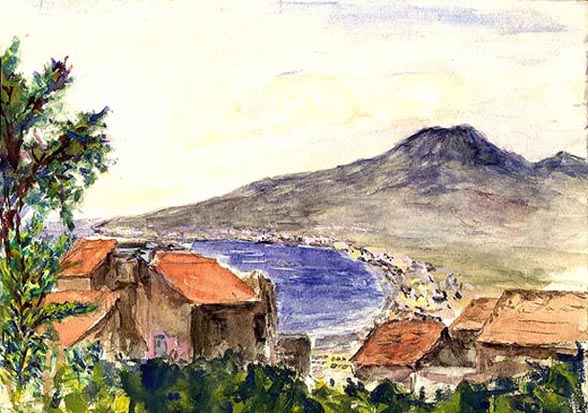
Gerhard's water color of the Vesuvio and the Bay of Naples from the balcony of the Youth Hostel in Castellamare di Stabia
After two days of rest I was better but too weak to pedal my bike. We decided to send the bicycles and our heavier luggage by train to Rome, because there was not enough money left to send them to Germany. Perhaps the German embassy in Rome would lend us some money. We would hitch-hike north.
We set out first on a painted Neapolitan two-wheeler donkey cart to the autostrada then on top a load of sacks filled with salt on a truck to Naples. It felt like flying with a sweeping view of the bay. At the outskirts of Naples kind people gave us a bag of overripe "cachi" - persimmons. We had never seen this fruit before - and Gerhard got so sick of their sweet taste that he never ate another one in his life! With newly restored energy we became incredibly lucky - a kind English gentleman loaded us into his fast Jaguar and in two hours autostrada we covered the distance to Rome which we had struggled nearly four days to pedal on our bikes.
The people in the German embassy were singularly unfriendly, after letting us wait for two hours, they all but threw us out of the house. What to do? We scratched our last Lire together and sent the bikes to the border station on the Brenner Pass, and with 2000 Lit left we walked out of town that night. Next morning incredible luck struck. Hungry and bedraggled we walked through the streets of Civitavecchia when a car with an undecipherable number plate stopped. Were we looking for a ride? asked the exotically painted lady in the car in French. Oui, I said, we were going to Florence.... Her name was Tilda and her husband's at the wheel Boni Ilel, they came from Istanbul.... Because of my poor French they changed to English, and when they found out where we came from Boni even collected a smattering of German. It became one of the unforgettable rides of our many thousand kilometers of autostop. In 1954 Gerhard and I would hitch-hike to Istanbul to visit them. Tilda distributed liberal quantities of rose-oil perfume, which clung to my sweater for the remainder of our journey - did we stink? - Meanwhile Boni worked the gas pedal to the rhythms of Turkish street songs: "Ïstanbulda gideriken...." A most glorious day.
Out of Florence - we were no longer the only ones thumbing at the roadside - a couple of priests loaded us into the cargo back of their Topolino. It rained in sheets, and they raced through the innumerable curves across the mountains at breakneck speed. The fumes of a gasoline can did the rest. Dizzy and shaken they freed us in Bologna with the ironic question: "Tutto sano?" Money... where to find the funds to go on. I finally begged a German couple in the train station to lend us 10 DM swearing that I would return it by mail within two weeks - they did not believe me - but I did....
On the day after Bologna the sun came out and we decided to tramp to Venice for our farewell to Italy. Crazy? Yes, but this day remained as one of the most beautiful memories of this summer. We walked all day long - the boats were too expensive - through the maze of vicoli, bridges, and canals. In the evening we tried to hitch back on the causeway. A big Mercedes with a Swiss license plate stopped. The driver rolled the window down and when I moved towards him spat at me and then roared off. I have never forgiven "the Swiss" this incident. We found a hay barn in Mestre for the night.
But the weather remained unstable, autostop difficult. We slowly made our way up the Etsch valley. In Bozen we slept in the barn of a German speaking farmer. Next morning his wife even gave us breakfast. And then we began to walk towards the Brenner Pass. Eventually an Austrian in a Volkswagen picked us up. He had the heater on, but we had to share the backseat with a huge German shepherd dog.... At the station the bicycles had been waiting for three days which emptied our pockets again, but the road to Innsbruck was all downhill. Once more I borrowed money from a German student in the Youth Hostel in Innsbruck before we pushed our bikes up the steep Zirler Berg to Mittenwald. Next morning we woke covered by a fresh layer of snow. But when the post office opened we were at last able to cash some money from our Postsparbuch and send the bikes to our parents address. The first thing we did in München was to order a huge portion of Sauerkraut with Bratwurst at the Hofbräuhaus. Alas, unaccustomed to so much good food I threw up the entire meal in the toilet.....
Tramping through Germany turned out even more difficult than in Italy, it was cold and rained most of the time. We slept in a barn with a Czech and a Greek hitch hiker, walked on foot from Pforzheim to Heilbronn - were given Kuchen and Kaffe by the monks in Unter-Wimpfen, and put up in a bed by a Methodist farmer in Heinsheim... and then I had a splendid idea, we hitched a ride on a Belgian barge going down the Neckar to Heidelberg! A glorious autumn day.... Two days later we walked through Gelnhausen to Tante Magda's house - who was shocked by our appearance. Brigitte was already studying in Köln. Between Göttingen and Kreuzriehe we used our student reduction on the train. It was Sunday 12 October before we reached home.